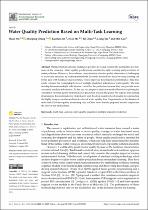| dc.contributor.author | Wu, Huan | |
| dc.contributor.author | Cheng, Shuiping | |
| dc.contributor.author | Ma, Nian | |
| dc.date.accessioned | 2022-09-06T09:30:56Z | |
| dc.date.available | 2022-09-06T09:30:56Z | |
| dc.date.issued | 2022 | |
| dc.identifier.citation | Wu, H. et al. (2022). Water quality prediction based on multi-task learning. International journal of environmental research and public health, 19(15), 9699. https://doi.org/10.3390/ijerph19159699 | en_US |
| dc.identifier.issn | 1660-4601 | |
| dc.identifier.uri | https://doi.org/10.3390/ijerph19159699 | |
| dc.identifier.uri | http://hdl.handle.net/10566/7812 | |
| dc.description.abstract | Water pollution seriously endangers people’s lives and restricts the sustainable development
of the economy. Water quality prediction is essential for early warning and prevention of
water pollution. However, the nonlinear characteristics of water quality data make it challenging
to accurately predicted by traditional methods. Recently, the methods based on deep learning can
better deal with nonlinear characteristics, which improves the prediction performance. Still, they
rarely consider the relationship between multiple prediction indicators of water quality. The relationship
between multiple indicators is crucial for the prediction because they can provide more
associated auxiliary information. | en_US |
| dc.language.iso | en | en_US |
| dc.publisher | MDPI | en_US |
| dc.subject | Water quality | en_US |
| dc.subject | Water pollution | en_US |
| dc.subject | Neural networks | en_US |
| dc.subject | Humans | en_US |
| dc.subject | China | en_US |
| dc.title | Water quality prediction based on multi-task learning | en_US |
| dc.type | Article | en_US |

